Although the internet forecast said it would be partially cloudy (which also suggests partially sunny) with a rise in temperature, the day started off in a grey shade and then more grey and a little bit more. Grey. In other words, not very nice weather-wise. But, let me not be petty – at least it was dry.
For this day I had planned an excursion to the Huong Son Complex of Natural Beauty and Historical Monuments which is on the UNESCO’s World Heritage List. However, when I originally inquired about a trip to this complex, a Perfume Pagoda regularly popped up. Over time, I had realized that the complex actually includes numerous pagodas and temples, divided into three groups, with the Perfume Pagoda standing out as the most prominent one. These pagodas and temples, as well as caves, are linked one with the other with a number of waterways.
As I’ve already mentioned, a good section of the north part of Vietnam is geologically made of limestone rocks and for this reason there is a huge number of caves, as well as impressive hilly and mountainous formations. Over time, the ancient Vietnamese built in this part of the country a system of hundreds of Buddhist pagodas and temples in caves, on mountain slopes or on the banks of rivers and one of the most spectacular ones is Huong Tich Cave which is also said to be one of the most beautiful in the country. It is a part of the Perfume Pagoda, which as a notion does not represent one single site, but rather as a group it comprises an entire complex of temples and altars scattered on the slopes of the Huong Tich mountains.
The main season for a visit to the Huong Son complex goes from February to April and in this time a large number of Vietnamese, as well as foreigners come here to visit. Also, when the believers want to visit all of this thoroughly, they come for a few days, sleeping here as well, and then they can visit all of the venues that are sacred to them. We visited only a couple of places, but they were truly beautiful.
First we went to a small port of a sort. Actually, this is just a walled place on the bank of the Yen stream. We went into small metal boats paddled by women. Each boat received four visitors and Sneza and I just happened to be in the same boat with a couple from India. As the two of us adore India and often tend to say this is our favourite destination, we were really extremely glad to meet somebody from that fabulous country. Very quickly it turned out this was additionally great, because Alka and Rajeev are exceptionally nice, perfectly-mannered and extremely well educated people, and it was a true pleasure, as well as honour to hang around and talk with them.
As I’ve mentioned, the day was completely grey, so we could watch the nature we were going through in such tones.
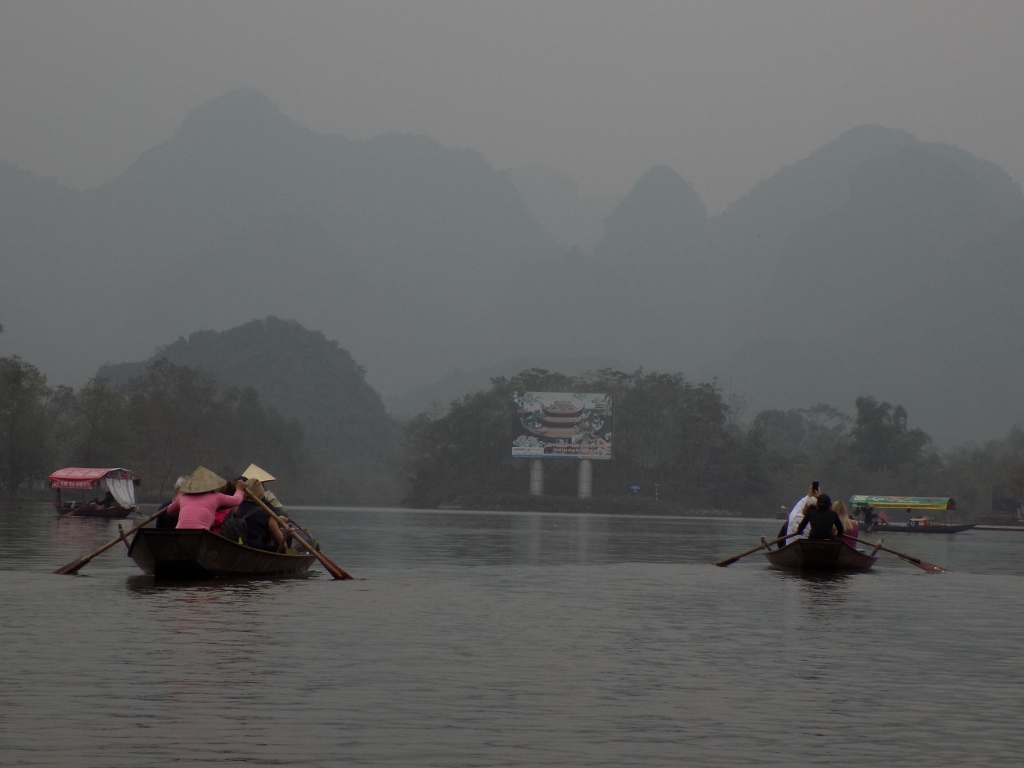 Sailing along the Yen stream
Sailing along the Yen stream
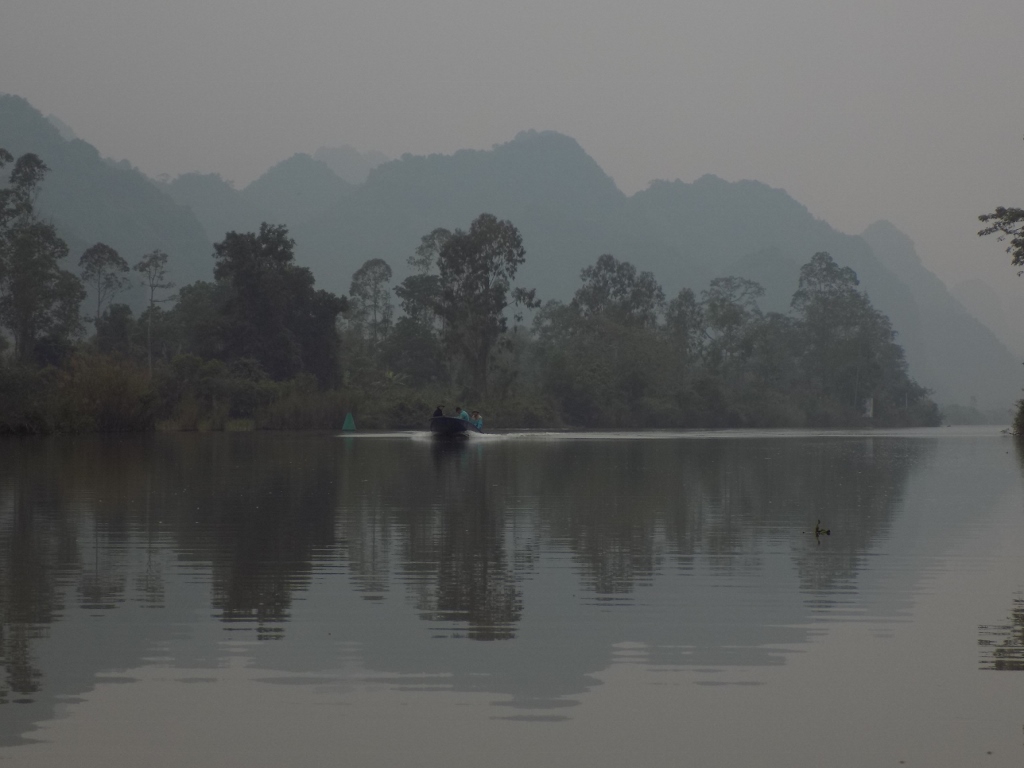 The Yen stream
The Yen stream
Occasionally we also passed by some tombs that were right next to the water or in the water itself. Generally speaking, throughout Vietnam we often noticed individual or group tombs that were located, for instance, in the middle of a rice paddy or at a foot of a hill, or here parallel to the river.
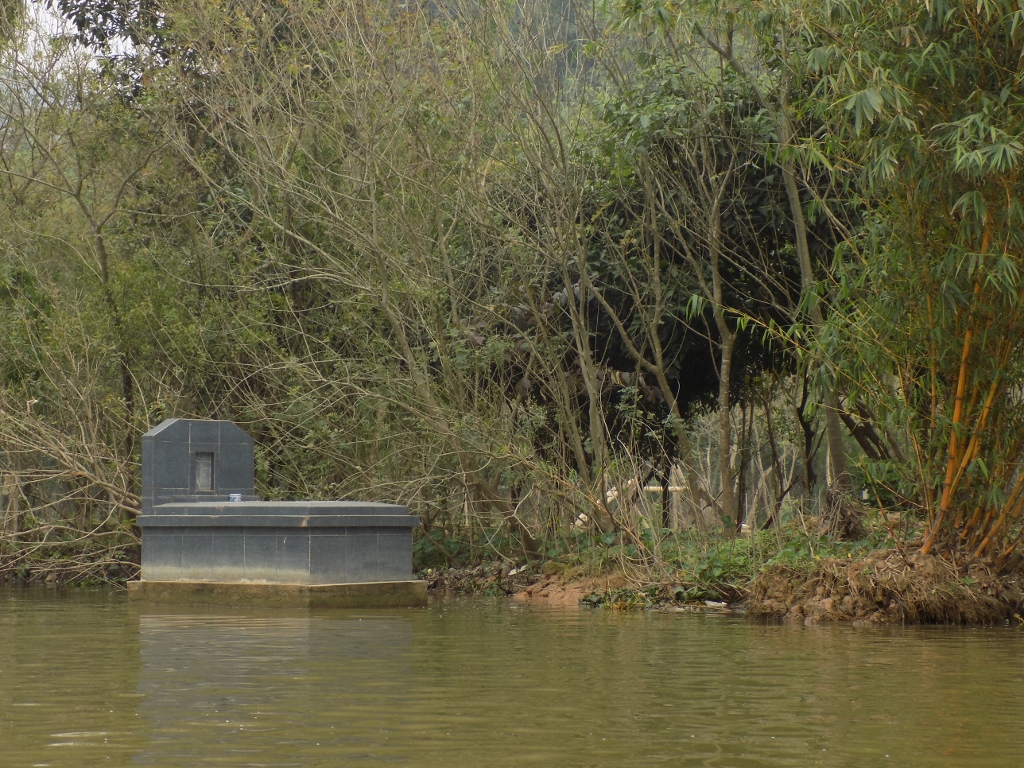 A tomb next to the Yen stream
A tomb next to the Yen stream
After an hour or so of slow floating down a calm river, we came to a place where we disembarked. On the shore we first came across some large plastic pots in which we could see snails and some creatures that seemed like water snakes. They told us these were eels in fact. They were there for sale to the believers who would then release them into water, I guess as a gift to gods or the Buddha or buddhas, thus getting some more fortune in their lives. The little birds we saw in cages around served for the same purpose and I couldn’t help but think that there would be enough fortune even if these poor animals had not been caught in the first place. On the other hand, those people who catch them and then sell them, what about their fortune?
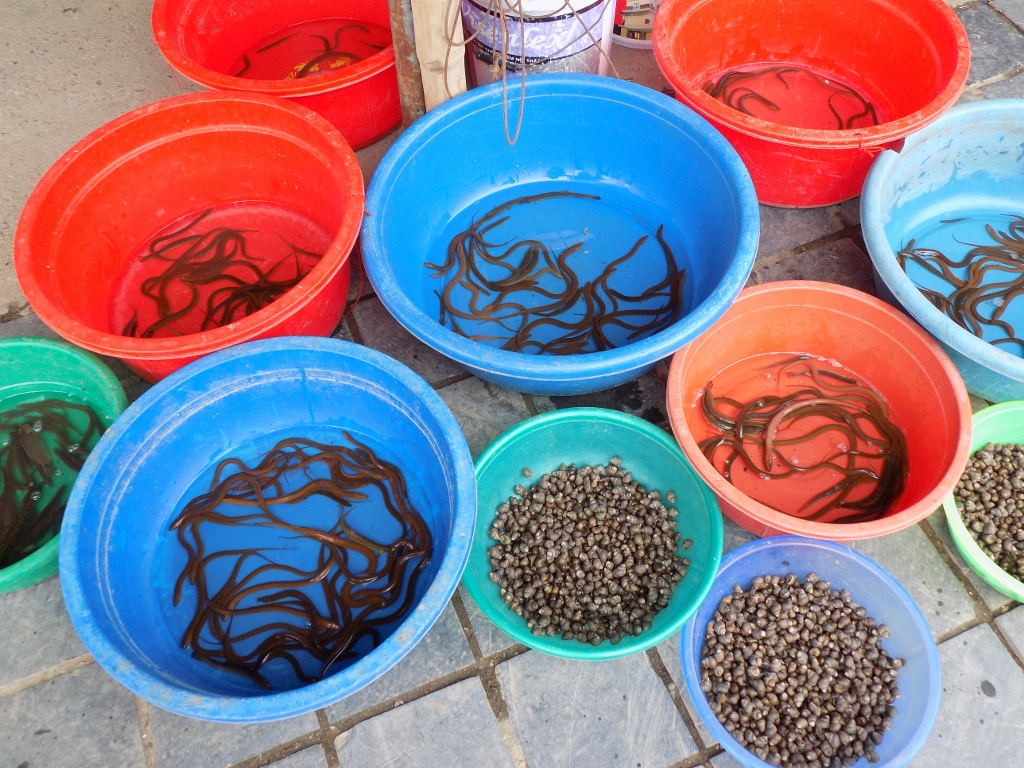 A simple way to get some fortune
A simple way to get some fortune
Be as it may, we first went to the nearby Thien Tru Pagoda, which means the Heaven Kitchen Pagoda. The entire complex around this pagoda was stunning and incredibly beautiful. I had problems though with understanding our guide, which made me a little nervous, and then I simply gave up trying to comprehend her and went for a leisurely walk around the complex on my own.
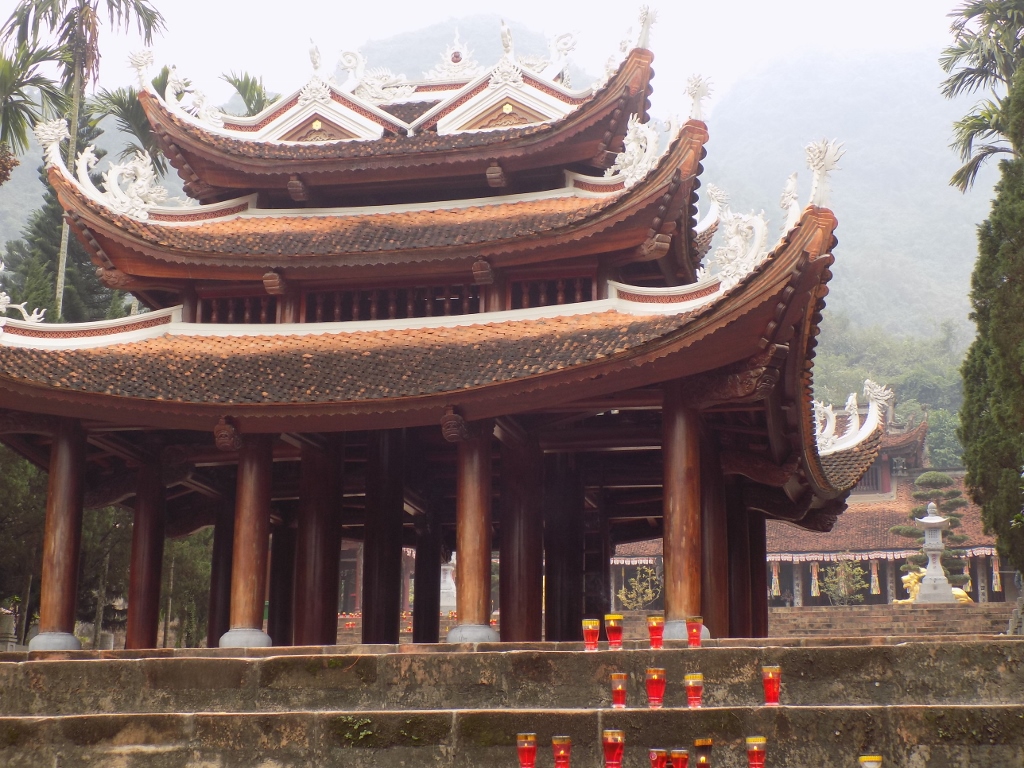 Thien Tru Pagoda
Thien Tru Pagoda
If you are travelling here during Vietnamese winter, which also includes January, then it may be rather cold and it is quite likely it will be clouded as it was the case with us. On the other hand, the advantage of this season is that there are much fewer visitors – both local and foreign, and thus one can enjoy some of the places without any disturbance. As I did that day.
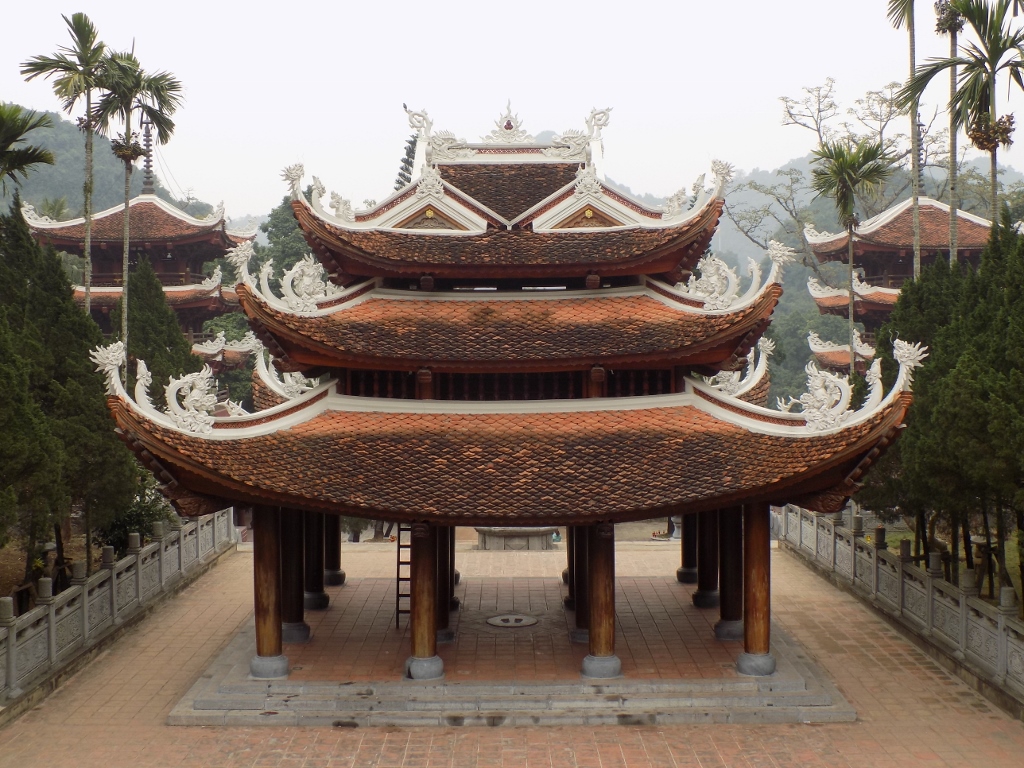 Thien Tru Pagoda
Thien Tru Pagoda
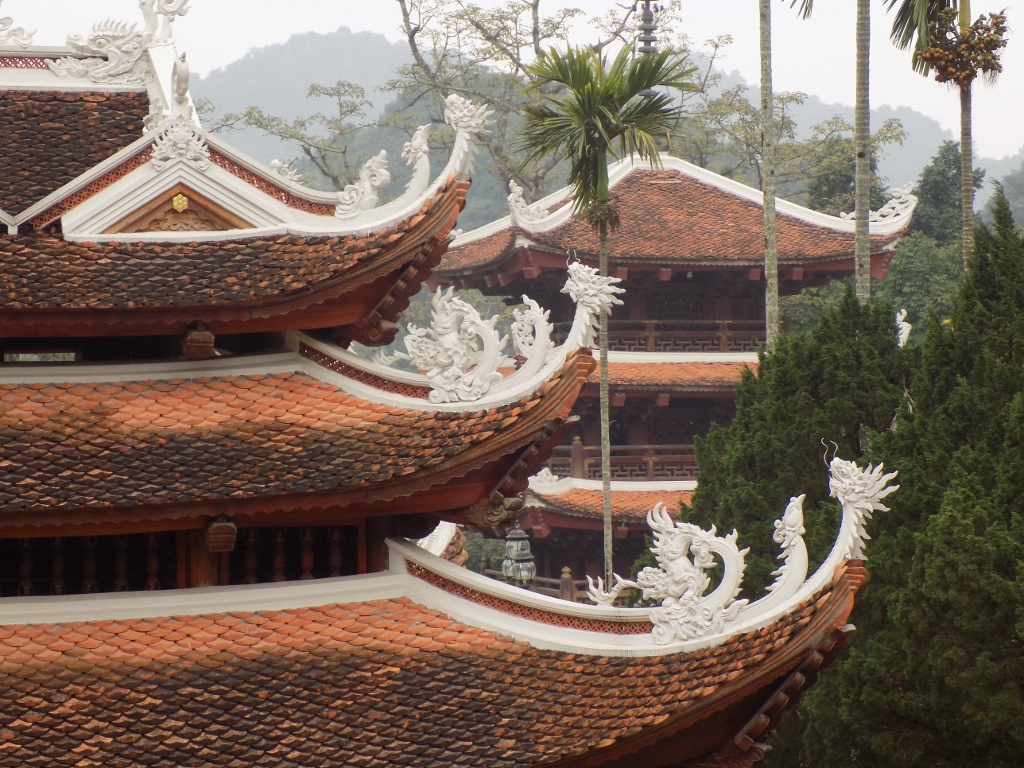 A detail of the Thien Tru Pagoda
A detail of the Thien Tru Pagoda
Having passed the structure that adorned the centre of one courtyard, I got closer to the central building which harbours sanctuaries and it all looked serene and in harmony with the nature around pagoda. I immensely enjoyed the beauty of the details that surrounded me.
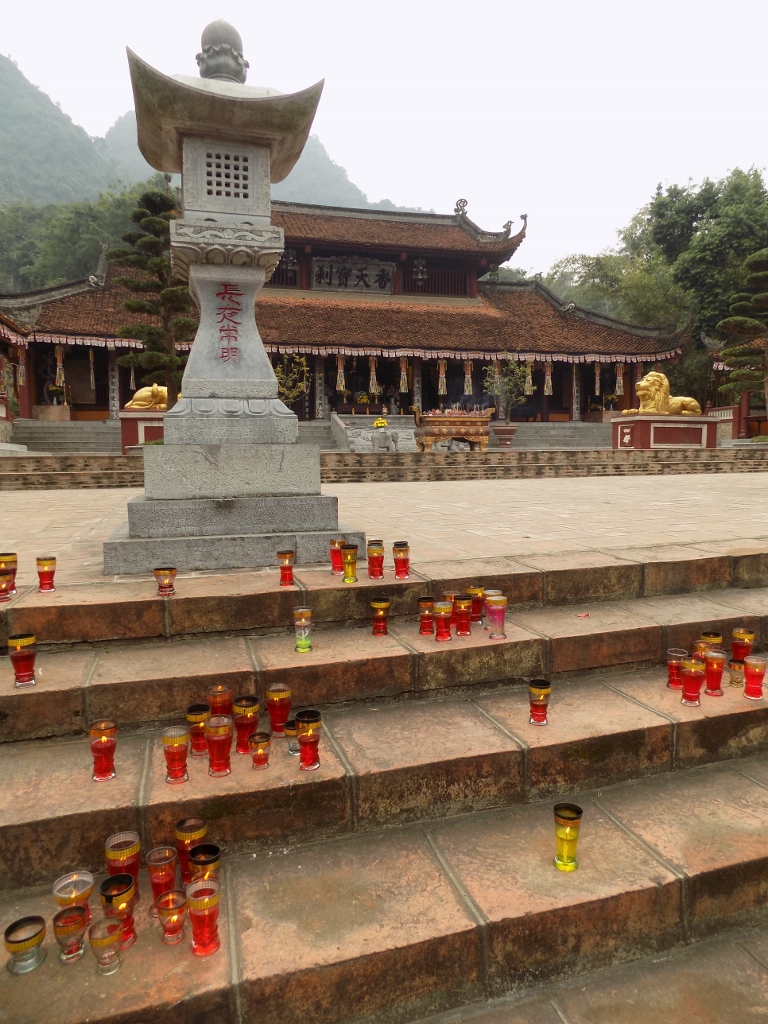 Central sanctuary of the Thien Tru Pagoda containing altars
Central sanctuary of the Thien Tru Pagoda containing altars
In order to enter the sanctuary with altars, one needs to take the shoes off, so I left my trainers in front of the entrance and I went inside. In front of the Buddha surrounded by mandarins and other important individuals, there were dishes with offerings.
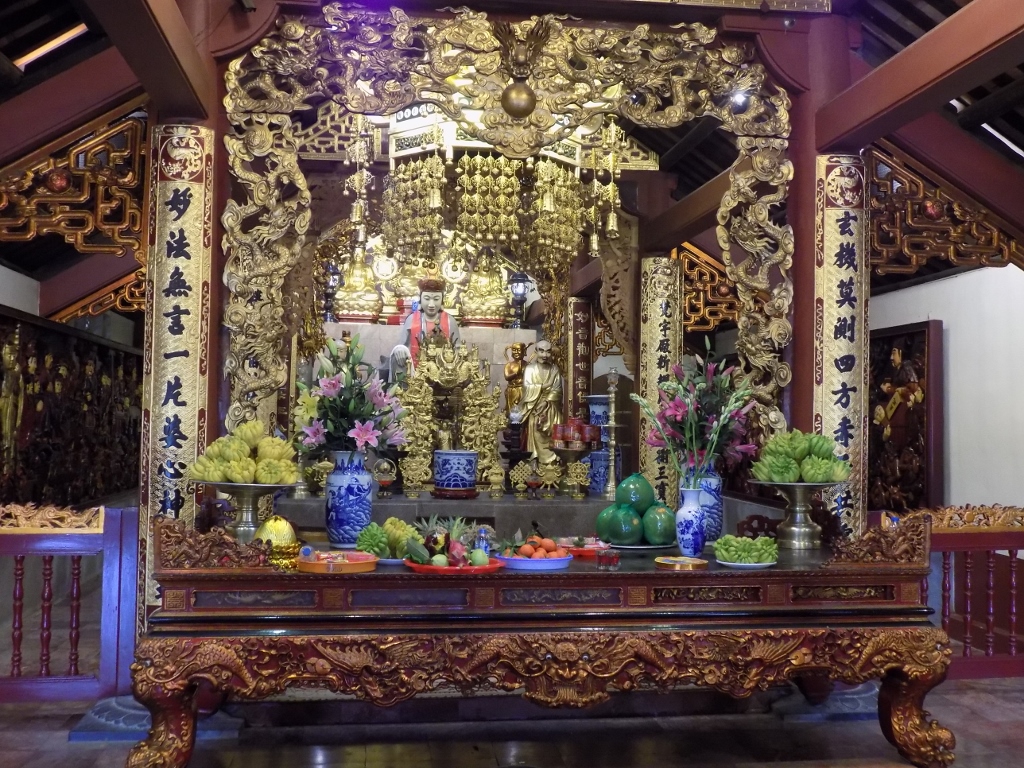 The main altar in the central sanctuary of the Thien Tru Pagoda
The main altar in the central sanctuary of the Thien Tru Pagoda
During our journey around Vietnam, we often visited pagodas and temples. Since we realized with time that it all seemed the same to us, we were curious to know what the difference was. Why is a building with one or several altars with offerings is called a pagoda, while another, which seemed identical to us, is called a temple? As it turned out they are not exactly the same. The difference is about who is on the altar. Since the Vietnamese revere their ancestors, emperors, kings, heroes and prominent individuals, they also place altars for them and bring them offerings, and such a place is called a temple. When the Buddha (in any version) is on the altar, then it is a pagoda. Practically, all else is the same.
After the visit to the central sanctuary, I went to a smaller building that is to the side of the central one and this one was particularly interesting to me on account of two blue lions placed in front of it as guardians. That pagoda contains statues of a female Buddha or rather of the female Bodhisattva of Compassion. By the way, bodhisattvas are linked with Buddhism and these are all the beings who devote their lives to easing the suffering of others.
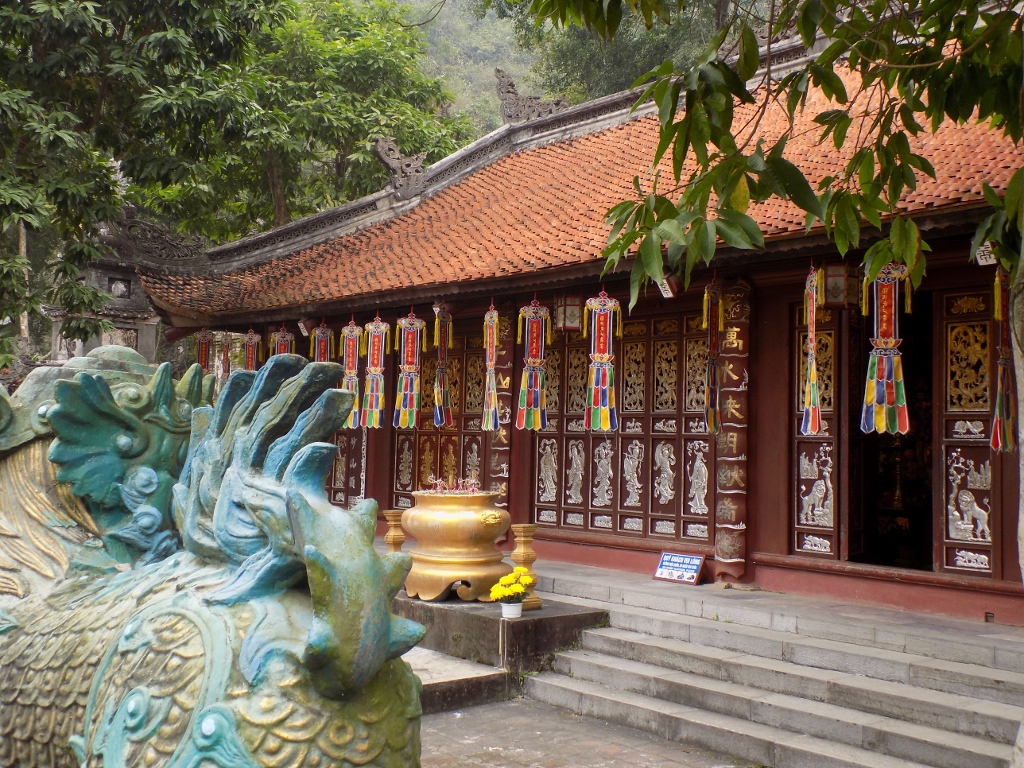 Thien Tru Pagoda, the sanctuary with the Bodhisattva of Compassion
Thien Tru Pagoda, the sanctuary with the Bodhisattva of Compassion
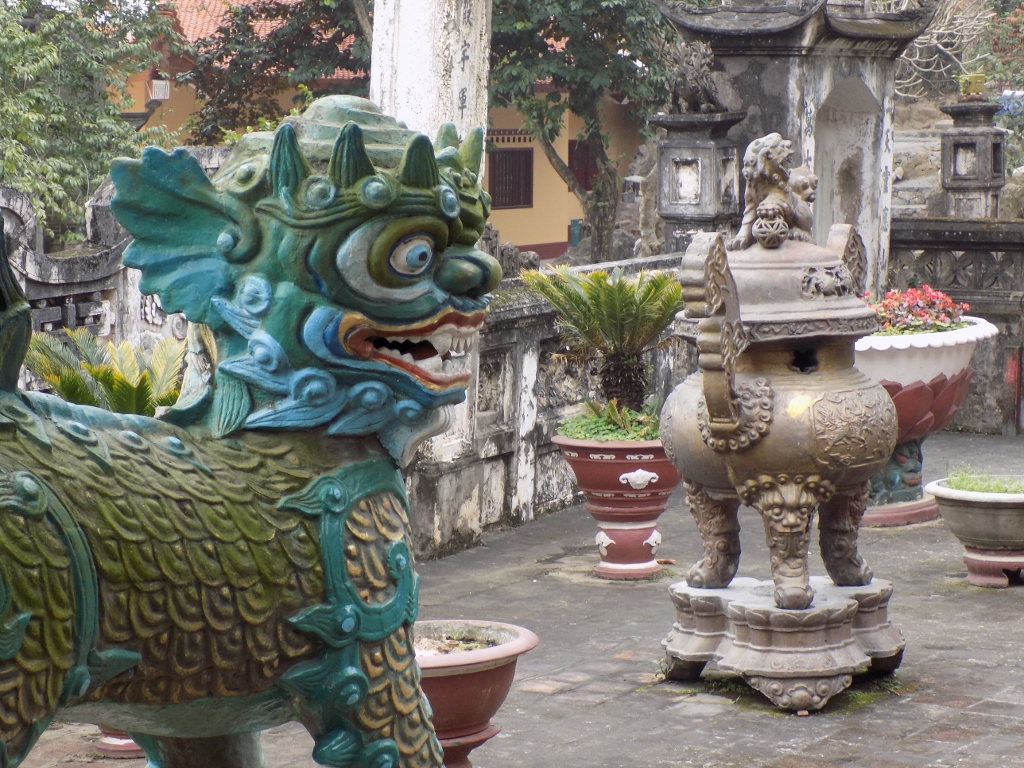 Thien Tru Pagoda, the sanctuary with the Bodhisattva of Compassion
Thien Tru Pagoda, the sanctuary with the Bodhisattva of Compassion
Then I joined the rest of the group and we all returned to a large plateau close to the river where there was a restaurant in which we had lunch and afterwards, Sneza and I, together with Alka and Rajeev, followed some steps up to a cable-car station, while the rest of the group decided to go on foot all the way. Namely, in order to reach the Perfume Pagoda, which was the next destination in our excursion, it is necessary to climb to one of the surrounding mountains and this is no small feat. Still, whoever wants to may go on foot up and down, following a broad path and numerous steps made of large pieces of stone. But, we decided to go up in a cable-car, which was quite a nice experience, provided that I decided to return on foot.
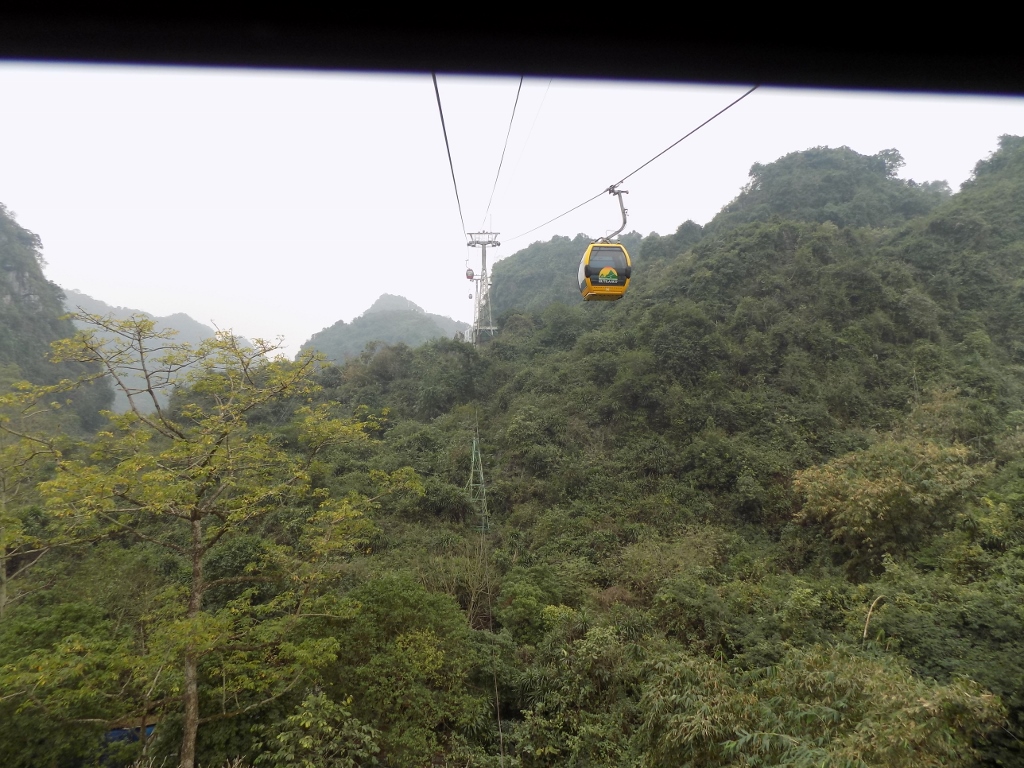 Cable-car leading to Huong Tich Cave
Cable-car leading to Huong Tich Cave
When one reaches the top station of the cable-car, it is still necessary to climb up a little, to a broad staircase that leads down into a spacious cave. In fact, the cave itself is not very long, but its approach appeared magnificent.
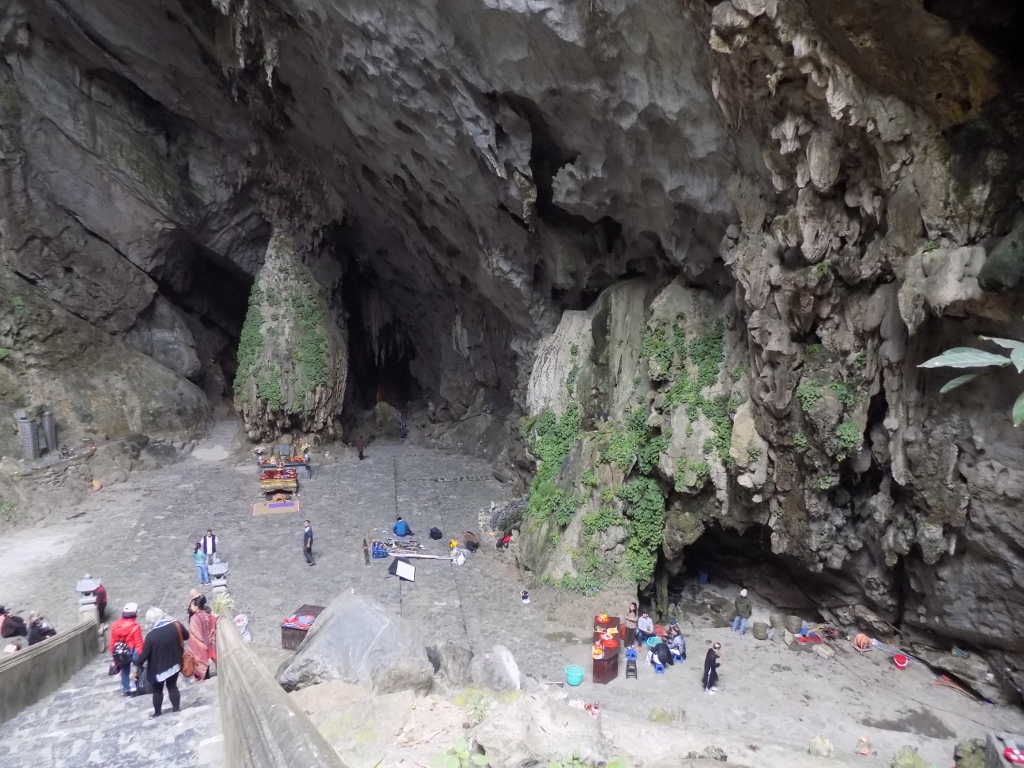 Huong Tich Cave and Chua Trong or the Inner temple
Huong Tich Cave and Chua Trong or the Inner temple
We descended and there the guide showed us the cave formations that remind people of some shape and thus there is something that appears like a path of elephants climbing upwards, i.e., going to the heavens, while opposite of them there is a rather deep hole and that is a symbolic hell. In the middle of the cave, there is a large stalagmite that resembles a grain of rice, which renders it certain symbolism – fertility and prosperity, and for this reason there are altars in front of the stalagmite.
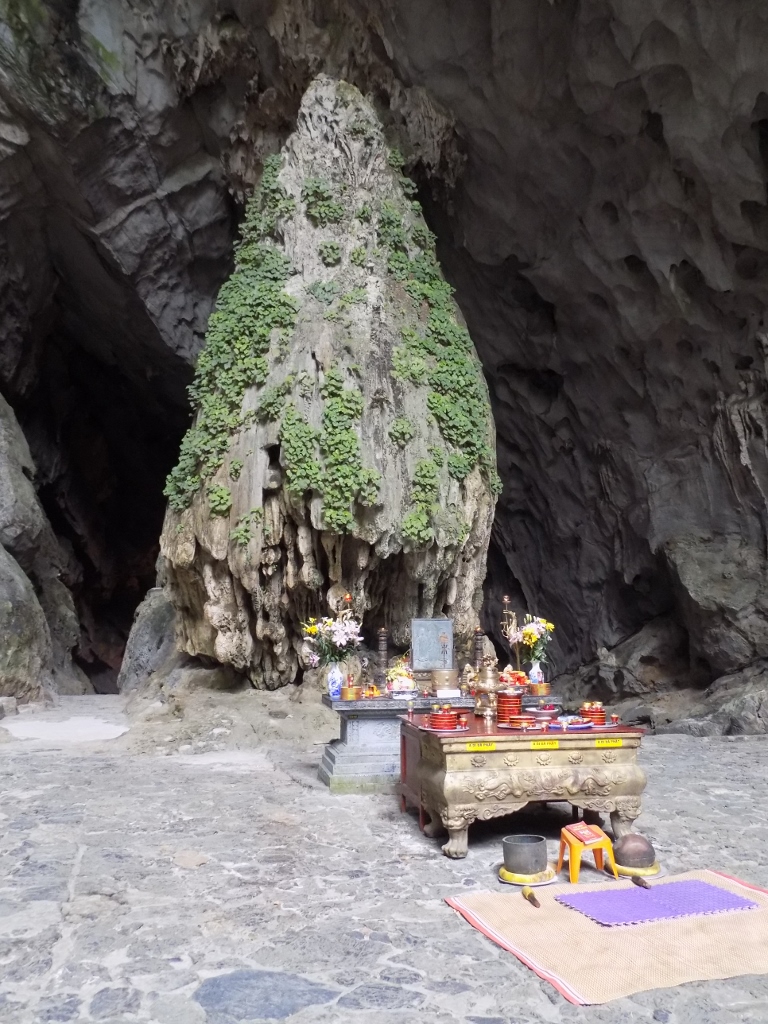 Huong Tich Cave, central stalagmite
Huong Tich Cave, central stalagmite
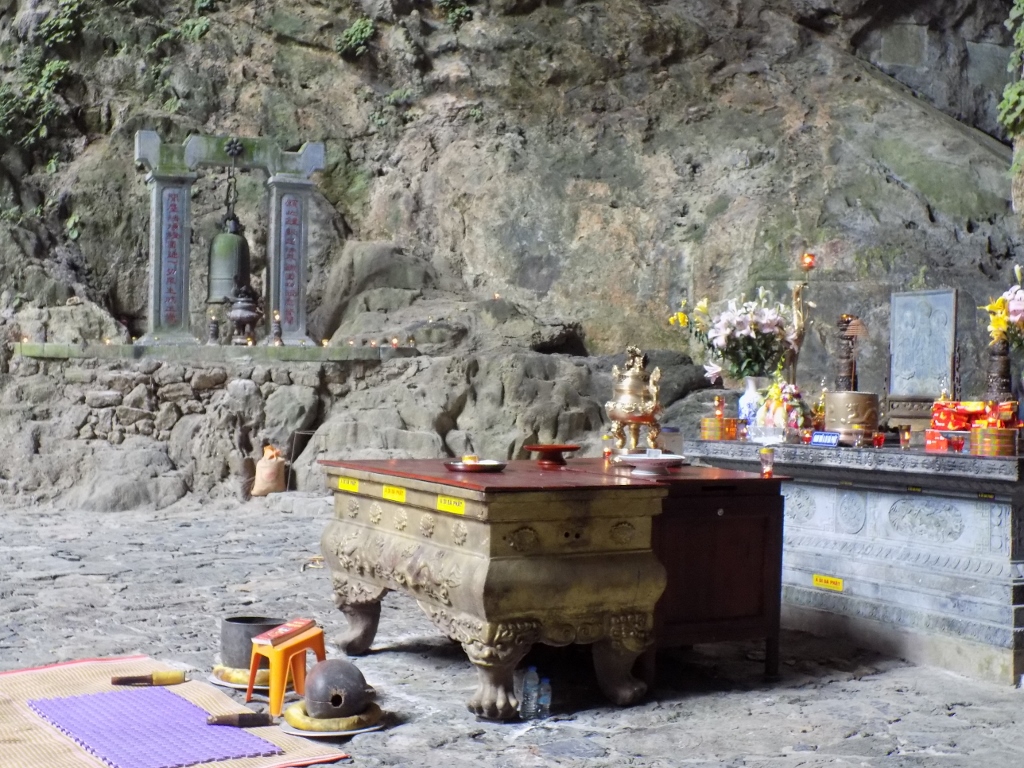 Huong Tich Cave, altars in front of the central stalagmite
Huong Tich Cave, altars in front of the central stalagmite
The view from this plateau at the staircase and the surroundings was spectacular.
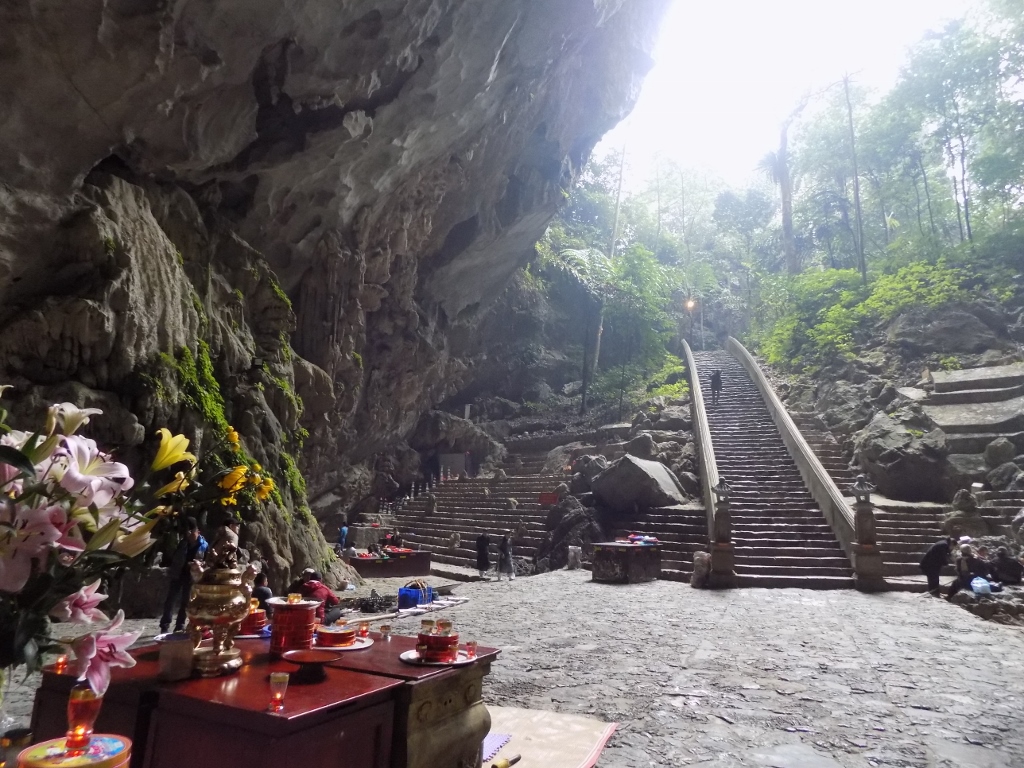 Huong Tich Cave, view at the access staircase
Huong Tich Cave, view at the access staircase
We then followed a path that leads beside the rice grain stalagmite descending to the inner sanctuary, but in the meantime we passed two other stalagmites where believers pray to get a boy or a girl, respectively. Male babies are more appreciated, because one day the son and the daughter-in-law should take care of the parents, while the daughter gets married and moves to another family. The Vietnamese tend to point out the fact that there are often three generations living in the same household, I guess because most of the tourists come from the “western” countries where this is a relatively rare occurrence. Frankly, in the household of my cousin, there are four generations living together and nobody makes a fuss about it.
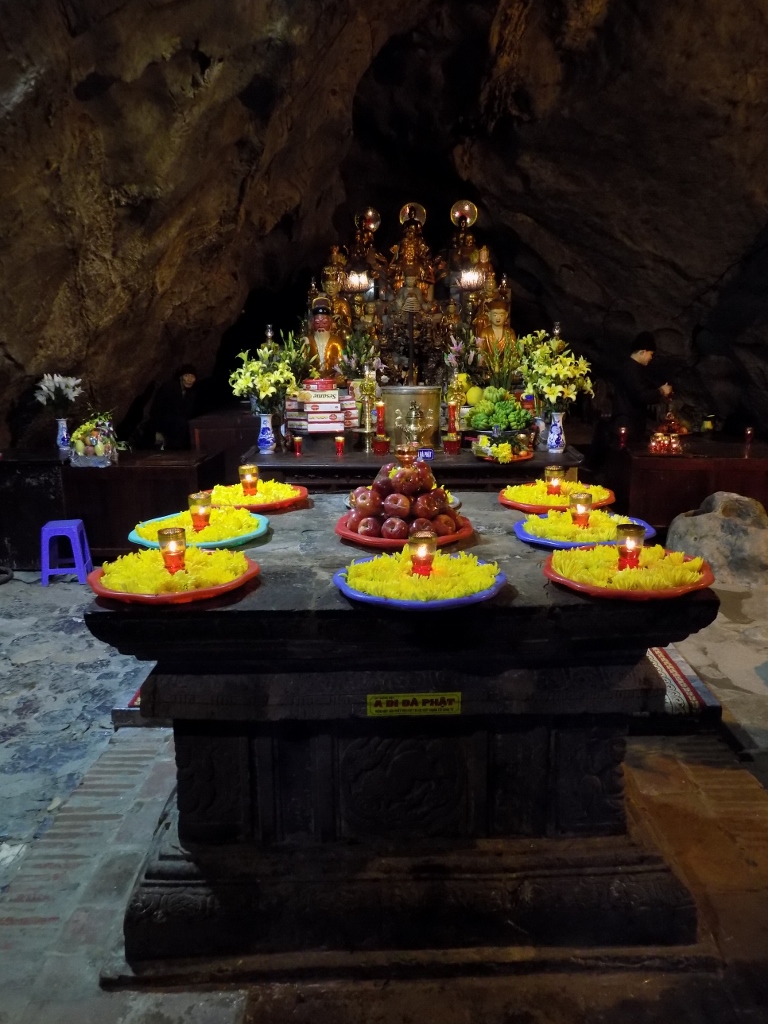 Huong Tich Cave, one of the altars
Huong Tich Cave, one of the altars
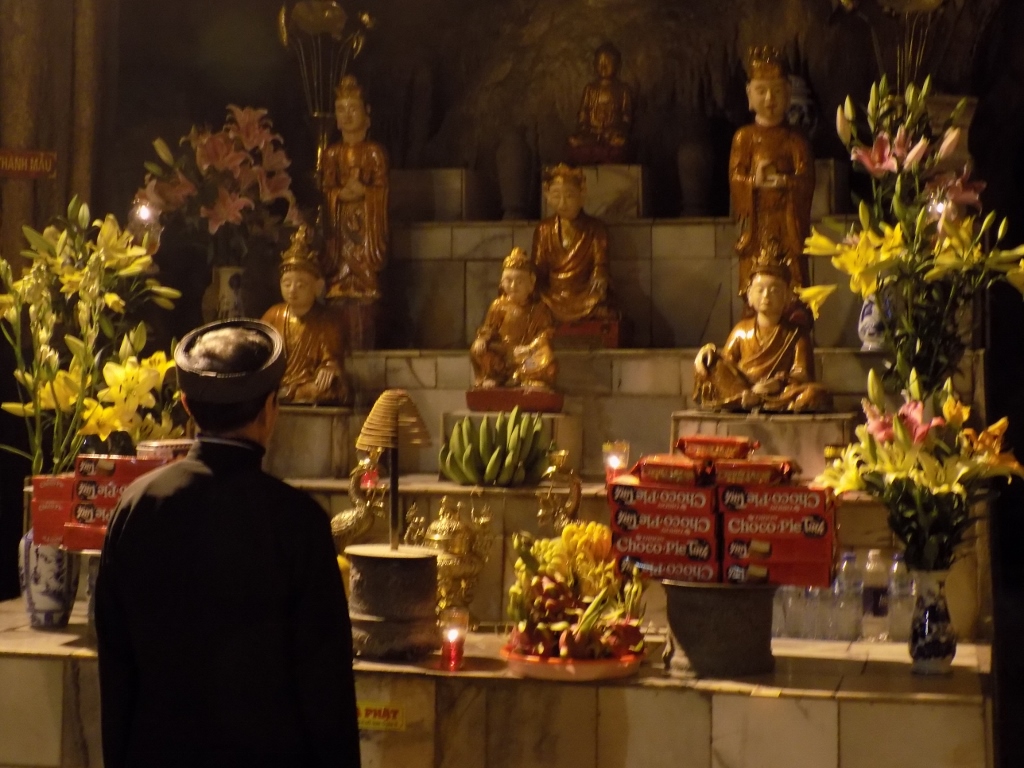 Huong Tich Cave, an altar with offerings
Huong Tich Cave, an altar with offerings
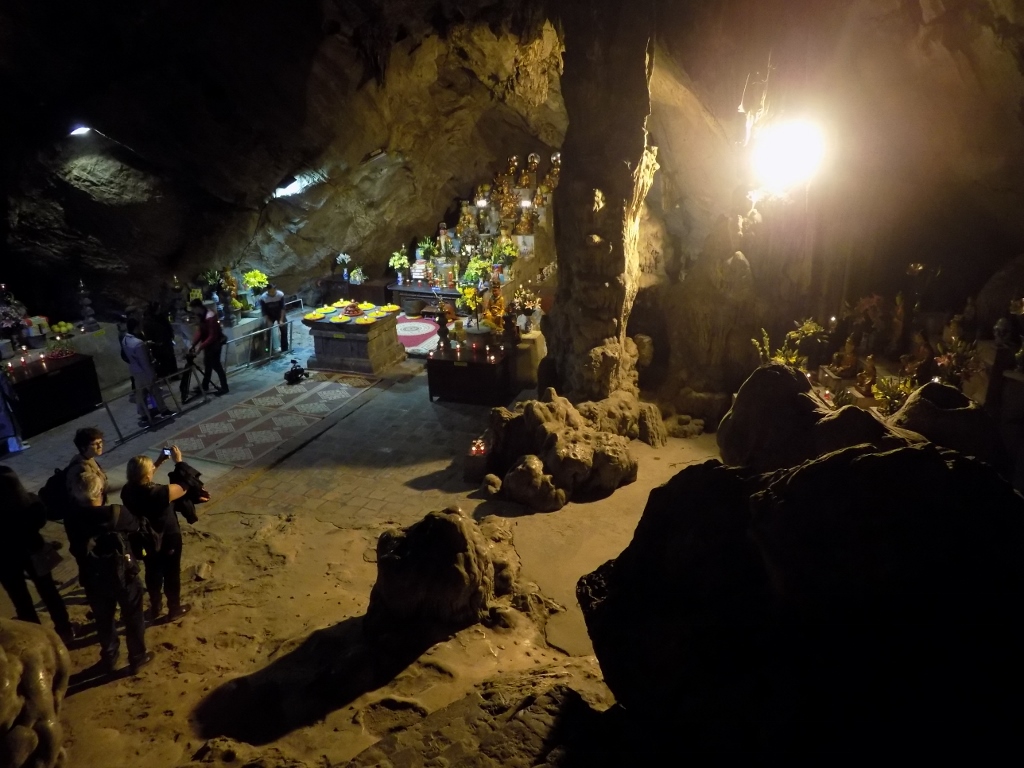 Huong Tich Cave, central sanctuary with altars
Huong Tich Cave, central sanctuary with altars
After a brief visit to the altars situated at the end of the cave, we started to go back following another path and there we passed beside a stalagmite whose exposed parts seemed completely polished because the believers regularly rub them with their hands, since it is believed that in this way one prays to the Buddha for money. Another stalagmite which is specific for the fact that it is continuously wet, i.e., water drips on it even in the dry season, is “in charge” of good fortune and health. It is not possible to have surplus of these two, so we all first touched the wet stone and then touched our heads.
As we were getting out of the cave and back to the plateau at the bottom of the staircase, we got the amazing view again. Regardless of the people around me, I felt as if I were in some lost world.
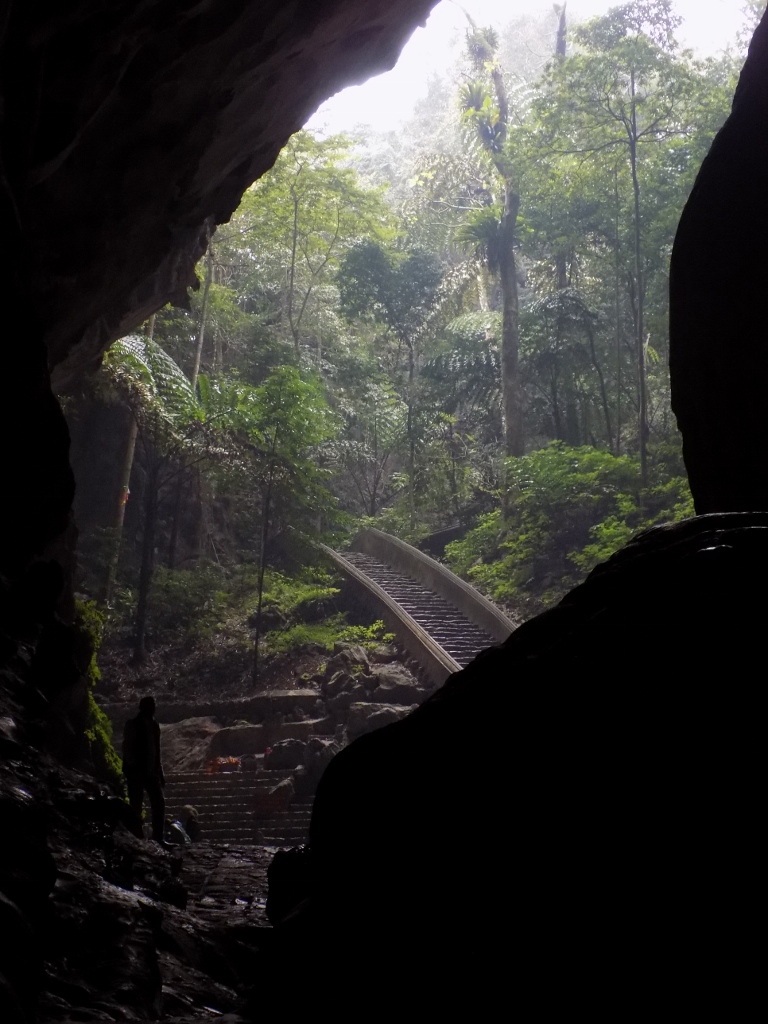 Huong Tich Cave, slowly getting back into the daylight
Huong Tich Cave, slowly getting back into the daylight
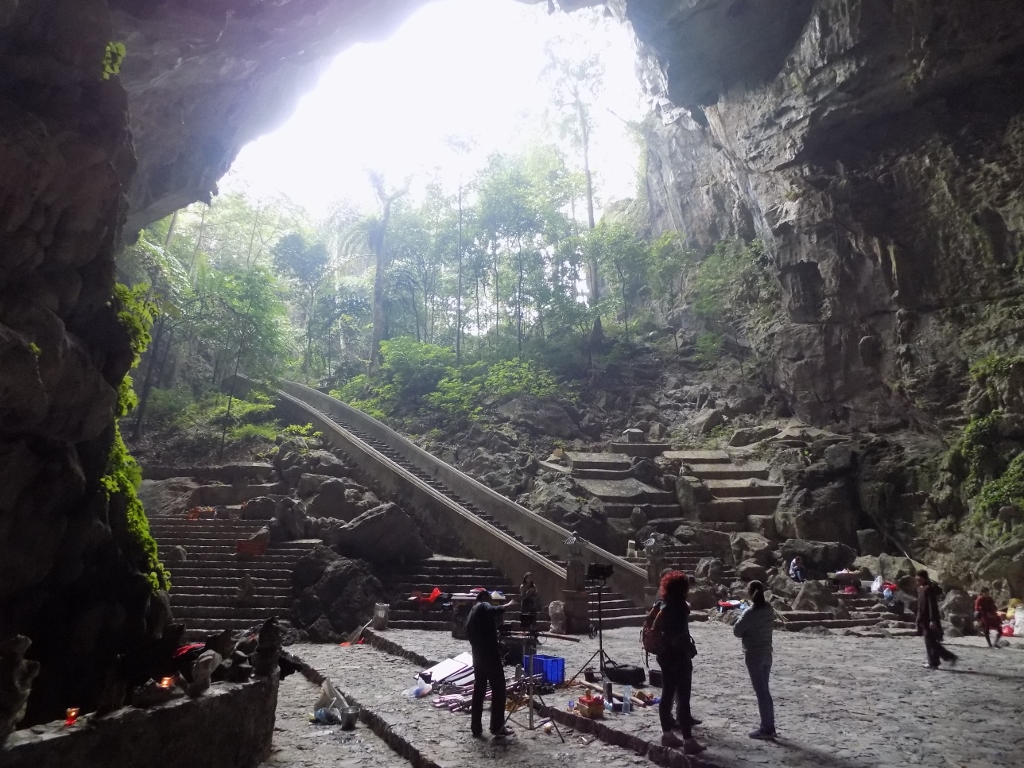 Huong Tich Cave, access to the cave
Huong Tich Cave, access to the cave
Then we started to return and there I parted from my small group heading down the mountain on foot. I had imagined I would be having some nice views and enjoy the nature. I had none of that. On both sides of the path, there were large rugged and improvised shop-stalls. Moreover, since it was a dead season, they were all closed and all I could see were huge plastic covers and no pretty views.
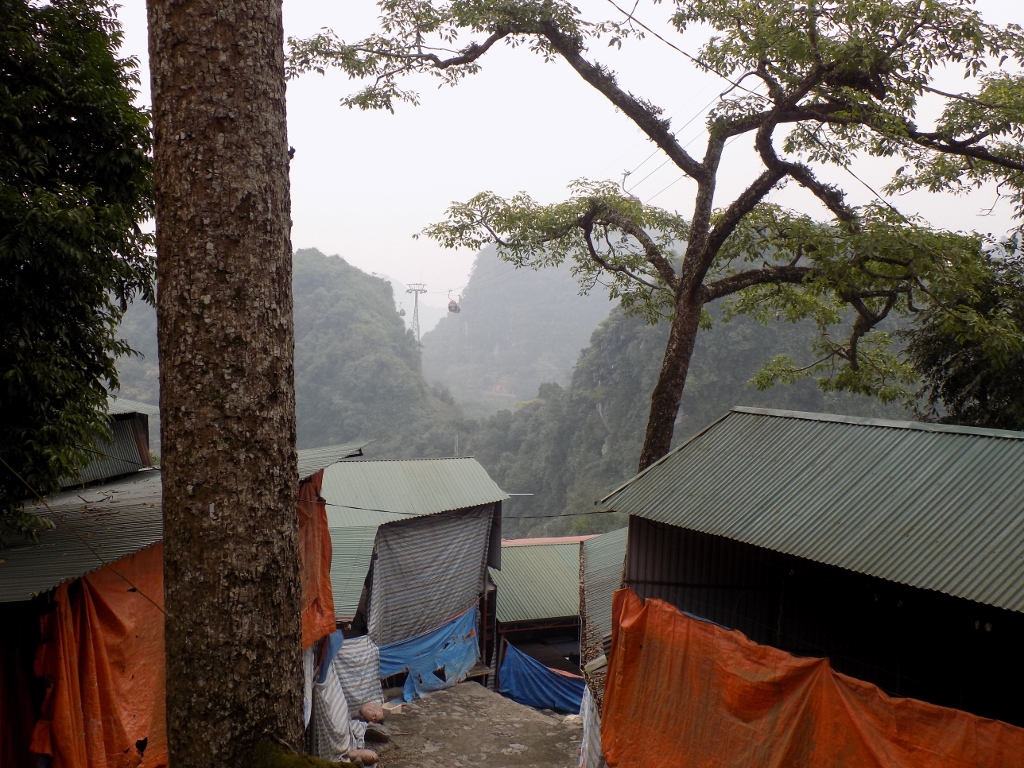 Walking path leading from Huong Tich Cave, with the cable-car visible
Walking path leading from Huong Tich Cave, with the cable-car visible
Still, from a few spots I could see the cable-car that was motionless at the time and I realized my fellow travellers had still not left the top, so when I came across a board which pointed towards Giai Oan Pagoda, only 35 m away from the path, I could not resist, so I went to visit it. There was nobody else there. I had actually seen the pagoda from the cable-car on my way up and it had appeared as if stuck to the rock. In reality, the building which contained altars was indeed built right next to the rock, but there was also an entrance into a cave behind the pagoda. I entered only the cave that was small, narrow and shallow, and it also contained a couple of smaller altars.
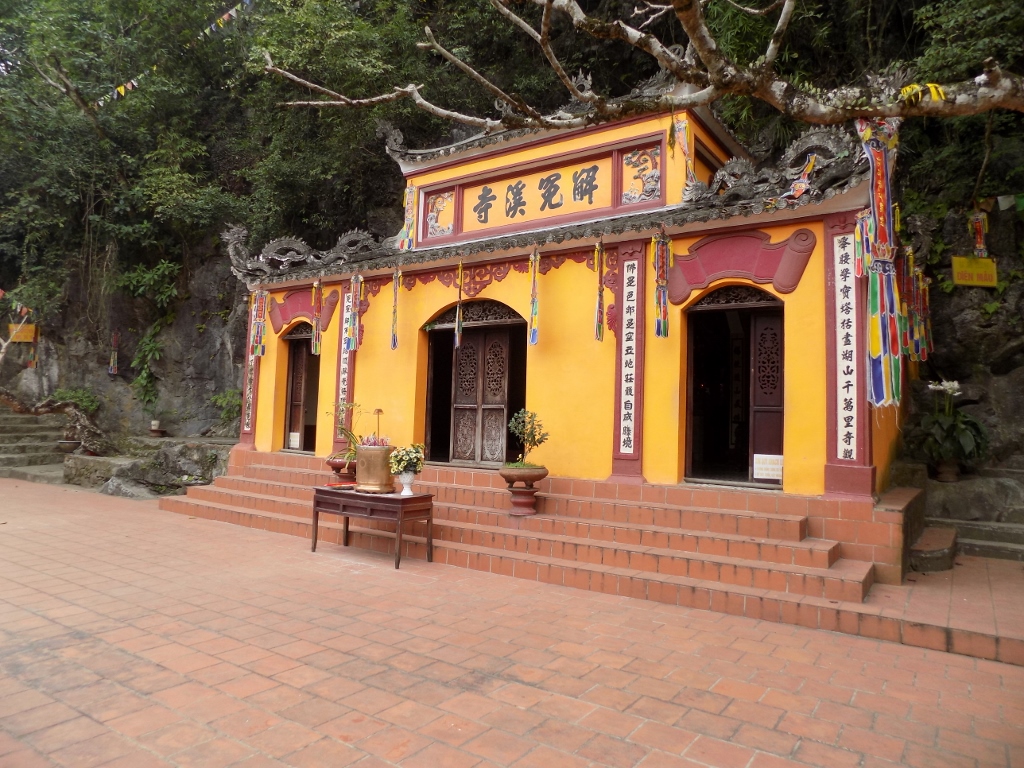 Giai Oan Pagoda
Giai Oan Pagoda
Once I had finished with this brief sightseeing and returned to the path, I could see that the cable-car was moving. Soon, I reunited with Sneza and not much later our entire group gathered, so following the same route, along the Yen stream, we went back to the place where we first embarked a few hours earlier. We transferred into the mini-bus and returned to Hanoi.
When we got back it was evening alright and it was our last day in Hanoi, so we agreed just to go for a brief dinner. Close to our hotel we found an excellent place, at the crossroad of two busy streets. There was a display refrigerator in which we could see different versions of meat, sea food and vegetables, mostly put on skewers. You select what you want to eat, that is then grilled right next to the fridge and then it is brought to you at the table, where they put it over a metal dish which is being heated (under the dish there is a small gas stove) and which is covered by aluminium foil in order for the food to be hot all the time. The most important was the process, almost a rite, and it was great!
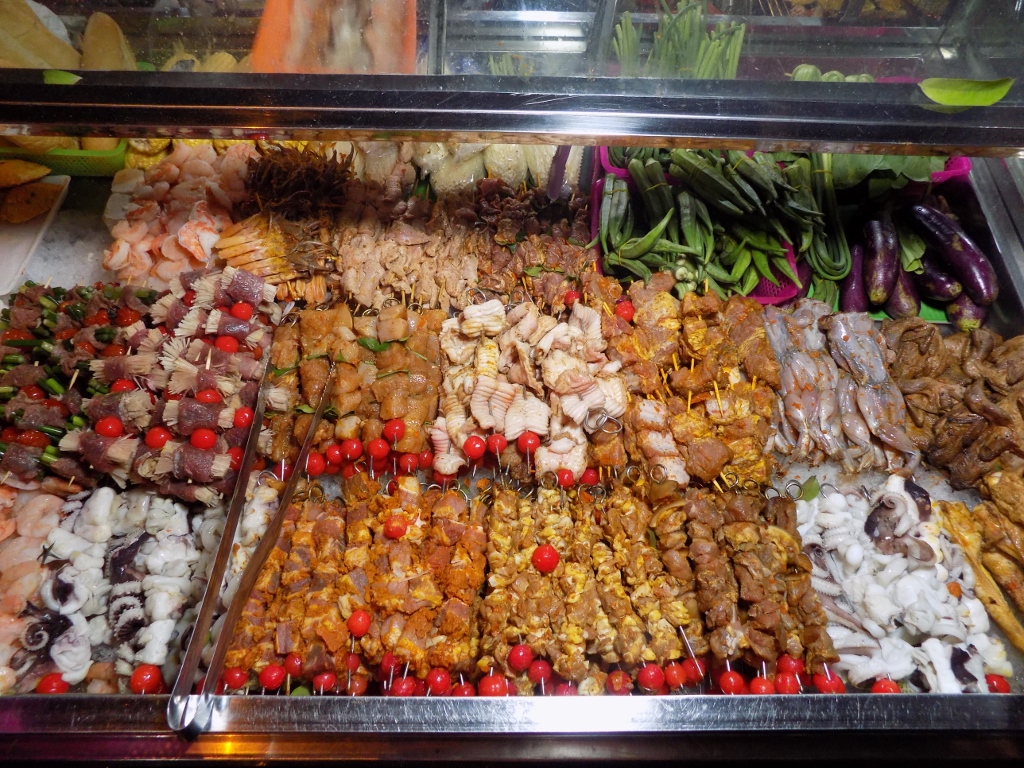 Fridge with fresh food
Fridge with fresh food
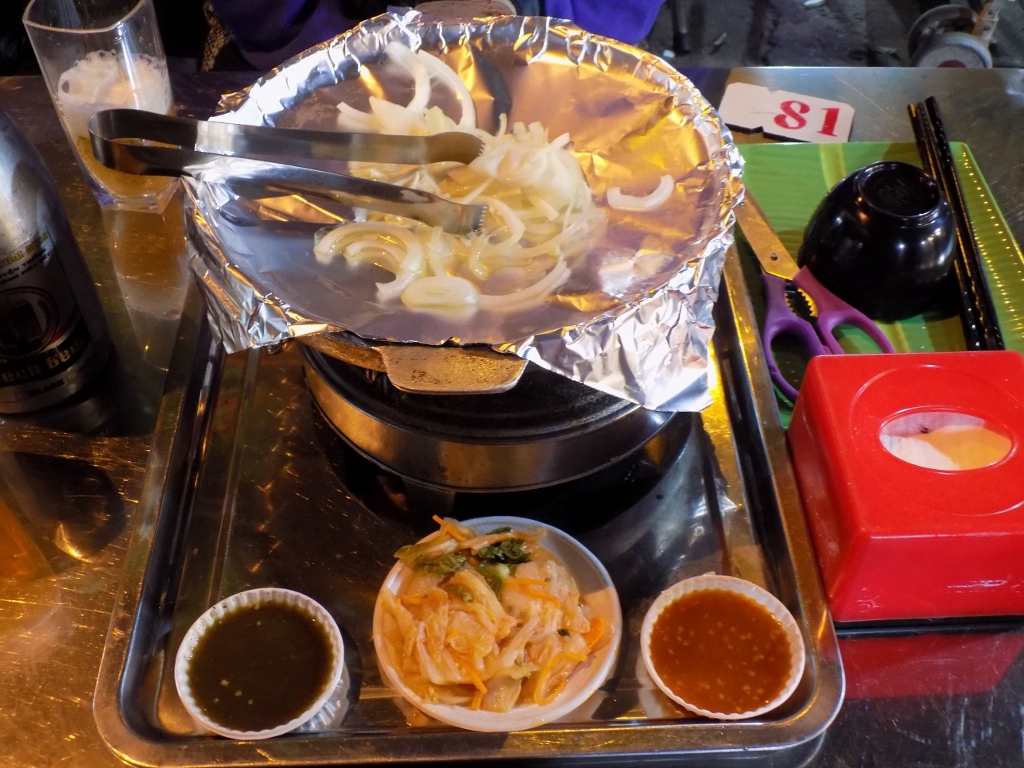 Onion slices, while we are waiting for the meat to come
Onion slices, while we are waiting for the meat to come
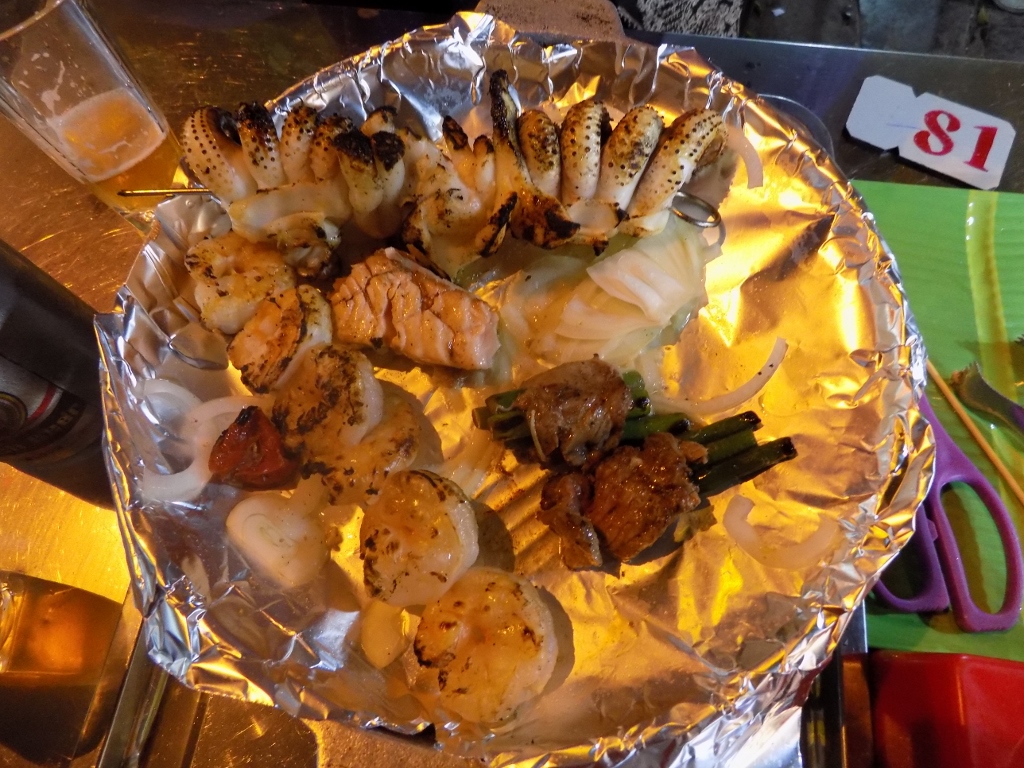 This is just the beginning; later I didn’t even take photos as I was too busy eating
This is just the beginning; later I didn’t even take photos as I was too busy eating
With the food I ordered a beer and not just any, I ordered bia hoi. Namely, some 40 years ago, Czech beer makers taught their Vietnamese colleagues how to brew beer daily, with no additives and preservatives, so it has to be consumed the same day it is produced. It is typically served in special metal bottles and the one I was having even had written on the bottle it was Czech beer. It was excellent!
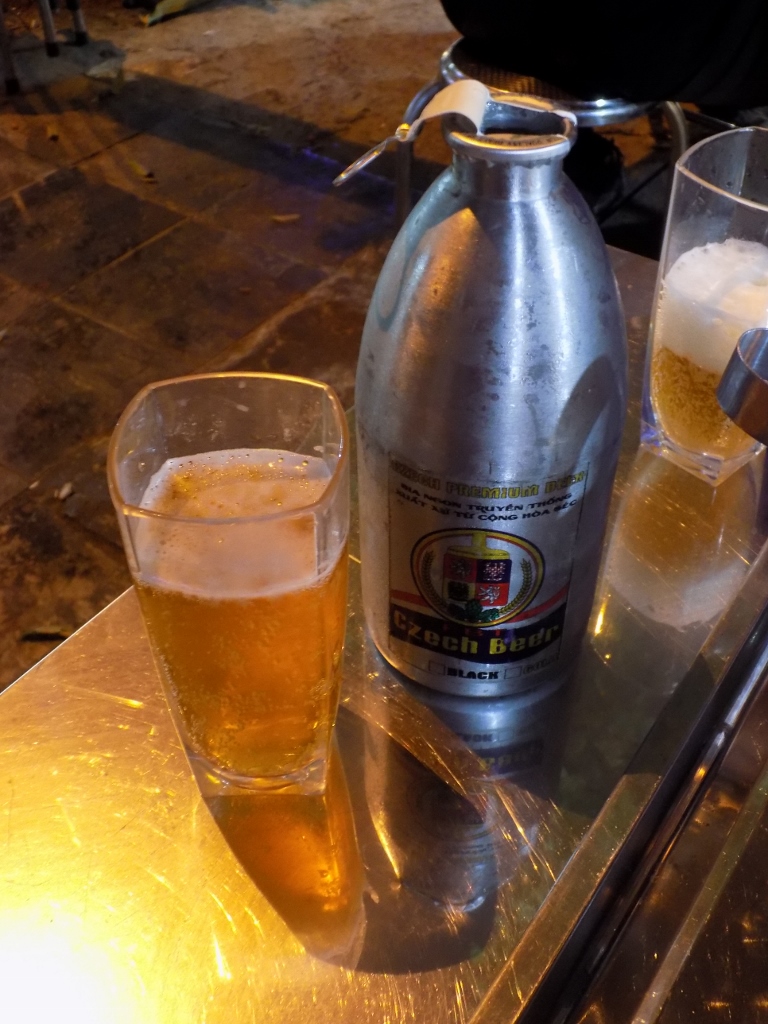 Bia hoi – “Czech” beer in the middle of Vietnam
Bia hoi – “Czech” beer in the middle of Vietnam
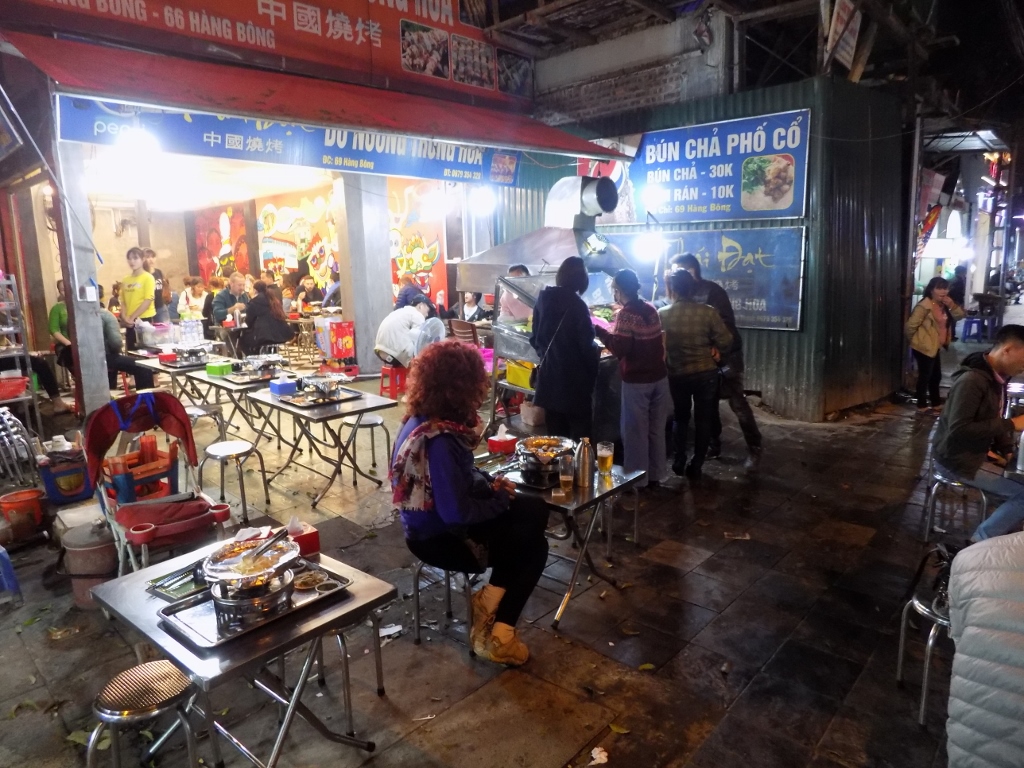 Restaurant in which we had great food (and beer)
Restaurant in which we had great food (and beer)
After this tasty meal, we went back to the hotel in order to pack up for we had tickets for the morning train to Ninh Binh. The time had come to move to the south.